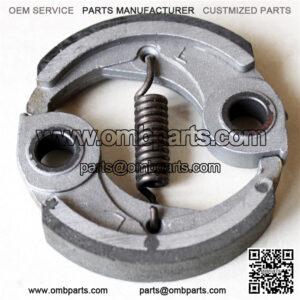How to Spot Common Riding Lawn Mower Clutch Problems:
There may also be a safety system malfunction, which may not let the blades engage.
With the first problem, nothing will happen when you activate the switch. This is a telltale sign of an electrical problem.
Most Common Riding Lawn Mower Clutch Problems:
The Electric PTO is Not Getting the Voltage Needed, or the PTO Solenoid is Toast
The Clutch is Slipping, Damaged, or Fused Together
A Safety Switch Somewhere Else is Causing the Blades Not to Engage
There is the possibility that another safety mechanism or switch is keeping the PTO from engaging. There are multiple switches in most mowers to ensure that you are safely seated on the mower when the blades start spinning. This may be a safety switch in the seat, or possibly a switch in the emergency brake or transmission. Try shifting your mower into neutral, engaging and disengaging the emergency brake, and make sure your weight is centered on the seat while engaging the PTO switch. Sometimes the switch under the seat may go bad or get dirty, and it will not sense your weight on the seat. The blades won’t turn on if that’s the case.
Symptoms of a Bad PTO Clutch on Your Lawn Mower (Mechanical):
These symptoms may indicate a mechanical problem with the actual clutch of the mower.
The Clutch Makes Noise When Engaged
If this is happening, your clutch may have a bad bearing, the surface of the flywheel may not be in good condition, or your PTO belt or pulley may need replacement. The belt slipping may cause the noise, so the first thing to check would be that the belt is tight and not damaged.
The Clutch Causes the Engine to Rev Higher
If the engine is revving up higher when you engage the PTO, it becomes evident that the power transfer from the engine to the blades is not working as it should. This may indicate some of the same things mentioned above. Your actual clutch may have a bad bearing and not be spinning smoothly, causing the engine to use more power. The PTO pulley may also have a bad bearing which would cause the engine to supply more power to get it moving.
The PTO Clutch Starts, Then Immediately Stops, and Fuse is Blown
This can indicate that the actual switch is bad or is not receiving enough power from the battery. You will need to do some electric PTO clutch troubleshooting to fix this problem. Listed below are the possible problems to check for if you experience this. You will likely need a multimeter to check for these.
Check the Fuse – The fuse for the PTO System is the easiest part to check and change. It should not be burnt, and you should be able to see that there is still a solid connection.
Battery Voltage – The battery may not be supplying enough voltage to activate the solenoid. This is a common problem, as lawn mower batteries can lose charge while sitting.
PTO Solenoid – This is the actual electromagnetic switch that controls the clutch, and replacing this part is a little more in-depth. You can check for its function with a multimeter.
Testing the PTO Clutch (Electrical)
If you tried to activate the PTO in the last step and nothing happened, it’s time to check some electrical connections.
1) Fuse – First, look for the wire that goes to the PTO mechanism. There should be a small fuse box containing the fuse for the switch.This means that the clutch was trying to draw too much amperage for some reason, and it usually points to some sort of mechanical problem (bad bearing, etc.). Replacement fuses are cheap, and you can replace it with the same amperage fuse that was in there. Usually, they are 10 or 15A.
2) Battery – If the fuse is good, the next thing to check would be the battery. You want to make sure the battery is supplying the correct voltage to the parts of the mower. Take your multimeter, switch it to Volts, and place the positive (red) probe on the positive terminal of the mower battery. Take the negative (black) probe and place it on a metal part of the engine. If your battery is putting out the correct voltage, the meter should read about 12.6 volts. Anything under that and your battery will need a charge.
3) Solenoid Function – You will want to find the clutch assembly under the mower, with the mower turned off, and unplug the wire that comes from the PTO switch. Put the key in the mower and turn it only to the first click. You don’t want to start the mower up, you just want the battery turned on. You will need to switch your multimeter to Amperage and connect the black probe to a grounded metal piece. Next, you will need to insert the red probe into the wiring harness coming from the switch. Activate the PTO switch and this should give you a reading of about 4 amps.

